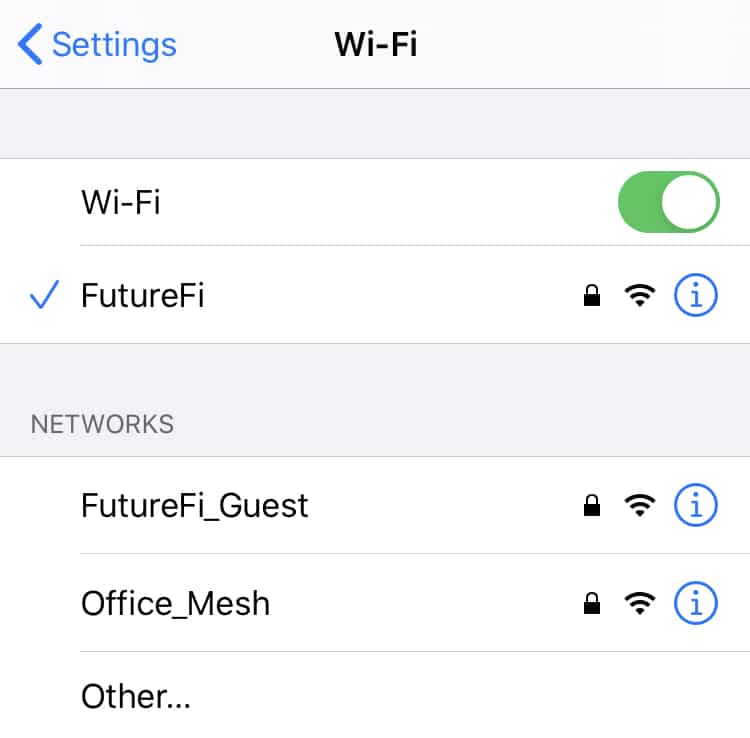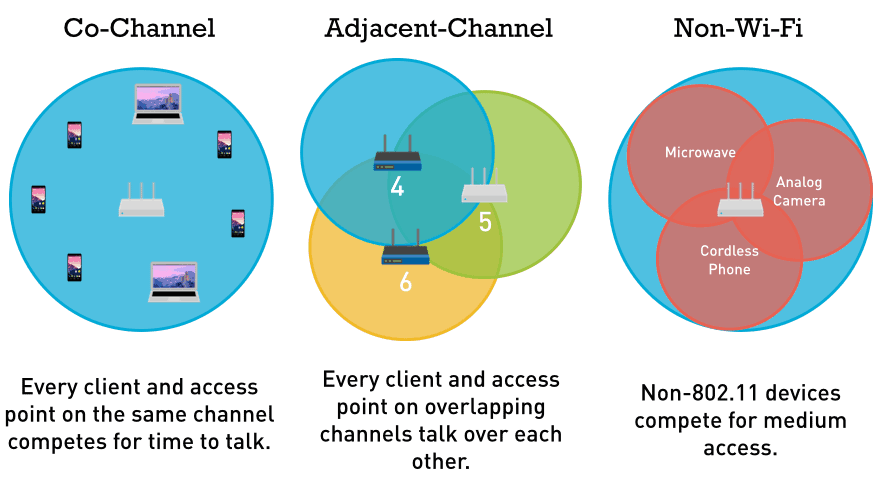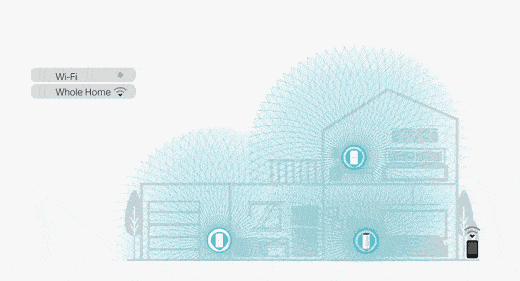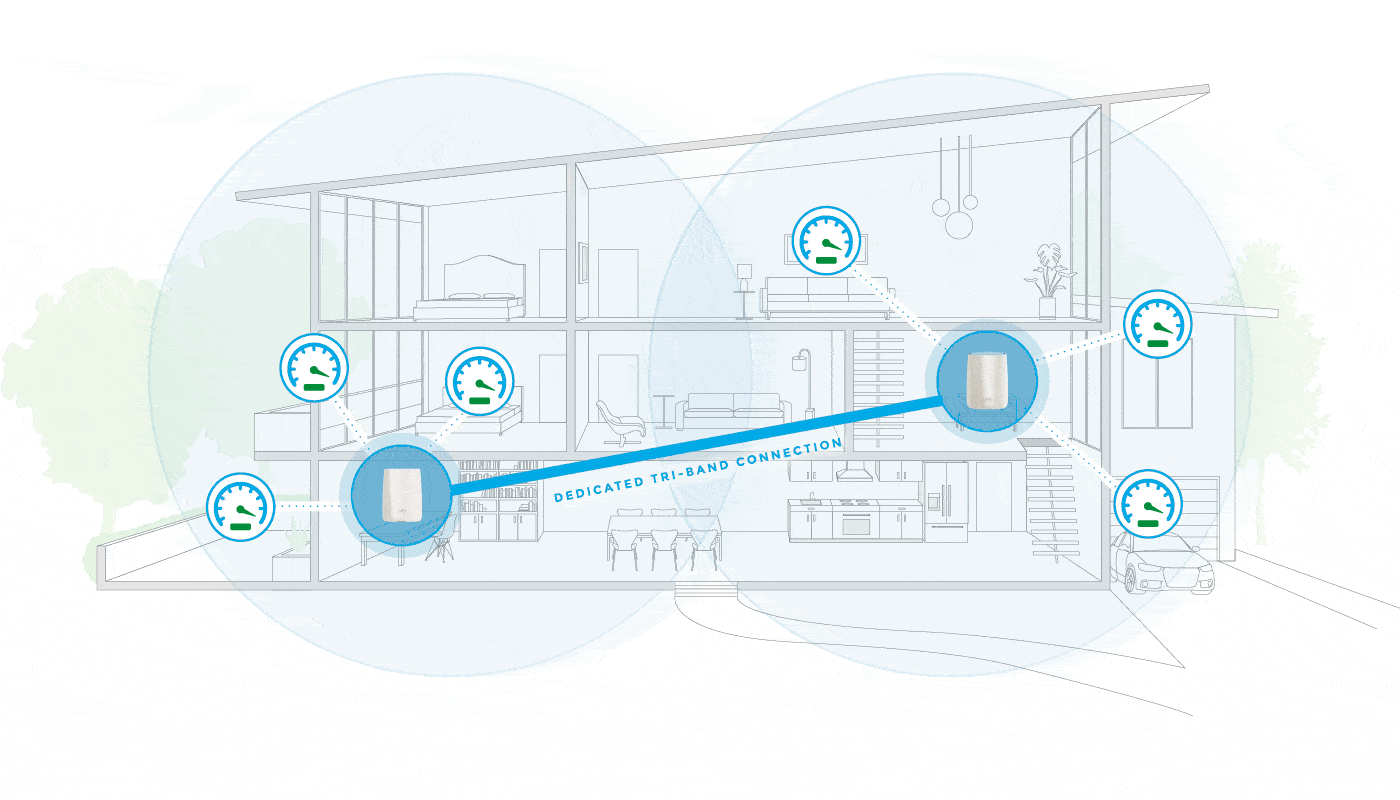When you’re setting up Wi-Fi at home or work, you might come across many technical networking terms and concepts that might be a little difficult to grasp. In this article, we’ll go over some of the key technologies related to Wi-Fi, and how they impact regular users like you and me.
IEEE 802.11 Wi-Fi Standards
IEEE 802.11 specifies a set of protocols for implementing wireless LAN (WLAN) communications over Wi-Fi between computers, mobile phones, access points, and other devices in various frequencies, including but not limited to 2.4 GHz, 5 GHz, and 60 GHz frequency bands. These protocols work within the Media Access Control (MAC) and Physical (PHY) layer of the OSI Model.
The original 802.11 protocol (which is now obsolete) initially specified just 1-2Mbps data rate along with the addition of a few other technologies. This was quickly followed by 802.11b in the early 2000s, which enables a raw data rate of up to 11Mbps and operates in the 2.4GHz band.
At around the same time, 802.11a standard was published, which uses an OFDM based air interface. It operates in the 5GHz band and has a maximum data rate of around 54Mbps, which realistically yields a net achievable throughput somewhere around the mid-20Mbps range.
In 2003, 802.11g was introduced, which operated on the 2.4GHz band, but used the same OFDM based transmission scheme used in 802.11a. This enables the maximum physical layer bitrate of around 54Mbps or around 22Mbps realistic average throughput. 802.11g hardware is fully backward compatible with older 802.11b devices.
In 2006, the 802.11n standard, a.k.a. Wi-Fi 4, was introduced. It supports both 2.4Ghz and 5GHz band; at the time, however, 5GHz support was deemed optional. This standard introduced support for Multiple Input, Multiple Output (MIMO) antennas and supported a maximum theoretical transfer rate of 300Mbps (or up to 450Mbps with three antennas). 802.11n is fully backward compatible with 802.11b/g standards.
In December 2013, after a long gap, 802.11ac specification was published, a.k.a. Wi-Fi 5. This was an extension of the 802.11n standard and adds full support for the 5GHz band. It was released in two phases or waves. Wave 1 came out in 2013, whereas Wave 2 was introduced in 2016.
Advanced technologies like beamforming, multi-user MIMO (MU-MIMO), more spatial streams (8 over 4 in 802.11n), and others greatly improved Wi-Fi performance, theoretically enabling up to 1300Mbps transfer rates per antenna (802.11ac).
The quest to improve wireless speeds continues. Multiple amendments to the wireless specifications have been made in the last few years. 802.11ax (Wi-Fi 6) has the goal of providing 4X the throughput of 802.11ac. 802.11ay enables theoretical throughput rates of up to 20Gbps and is intended to operate in the 60GHz millimeter wave (EHF) spectrum.
Note: There are many smaller amendments made to the 802.11 specifications in between the major ones mentioned above.
SSID & WPA2 Key
SSID is short for Service Set Identifier. Simply put, it is the Wi-Fi network name associated with an access point. Some SSID’s are available as open Wi-Fi networks, while others are protected.

To connect to a protected SSID, a Wi-Fi device needs to authenticate itself by providing the correct password. WPA2 (short for Wi-Fi Protected Access 2) is the security method added to the current generation of wireless access points that provides stronger security and access controls. The WPA2 key is essentially the password for your wireless access point.
Wi-Fi Frequency Bands
The Wi-Fi found at home or office generally operates in 2 distinct frequency bands. The 802.11b/g/n standards utilize the 2400MHz – 2500MHz spectrum, commonly regarded as the 2.4GHz band. The 802.11a/n/ac/ax utilize the higher, more regulated 4915MHz – 5825MHz band, a.k.a. the 5GHz band. Both of these bands are a part of the Industrial, Scientific, and Medical (ISM) radio bands.
Compared to the 5GHz band, the 2.4GHz band has a longer wavelength and thus a longer range, while the 5GHz band being a higher frequency, is faster and can accommodate higher bandwidth.
Apart from Wi-Fi, many regularly used wireless home appliances also utilize the 2.4GHz band. Baby monitors, wireless cameras, Bluetooth devices, cordless phones, microwave ovens, Zigbee (used in modern IoT devices), etc., all operate on 2.4GHz.
Wi-Fi Channels & Channel Width
The 2.4GHz and 5GHz are further sub-divided into smaller groups of frequency ranges called channels, that specific wireless devices use for transmitting or receiving data. The range of frequencies specified for a particular channel is called channel width.
A wider channel has more bandwidth and can transmit a larger volume of data simultaneously (higher throughput) compared to a narrower channel.
A total of 14 channels are designated in the 2.4GHz range (numbered 1 through 14), spaced 5MHz apart from one another, except for a 12MHz space between channels 13 & 14. While 802.11b was based on direct-sequence spread spectrum (DSSS) modulation and utilized a channel width of 22MHz, 802.11g/n is based on OFDM modulation and utilizes a 20MHz channel width. In both cases, however, the 2.4GHz band allows a maximum of up to 3 non-overlapping channels.

Channels in 2.4GHz band
Countries specify their own regulation laws for permissible channels. Channels 1 through 11 are available for use worldwide. Channels 12 & 13 are not permitted in North America (with some exceptions), while channel 14 is exclusively available in Japan.
So, considering worldwide availability, channels 1, 6 and 11 are the only non-overlapping channels you can choose from.
Note: Channel pairs like (2, 7, 12) or (3, 8, 13) are also non-overlapping, but then again, channels 12 or 13 are not available for use in the US.
Within the scope of WLAN/Wi-Fi, the 5GHz band has 130 channels labeled from number 36 to 165, each spaced 5MHz from another, similar to the case in 2.4GHz. But in 5GHz, only every 4th channel is used, which allows for all of the used channels to be mutually non-overlapping and 20MHz wide.

Channels in 5GHz band
Channel Bonding
The IEEE 802.11n (for 2.4GHz band) and 802.11ac/ax (for 5GHz band) standards made provisions for combining up to 2, 4, or 8 20MHz channels to form wider 40MHz, 80MHz or 160MHz channels. This is also known as channel bonding. As wider channels allow higher throughput, channel bonding allows for faster data transmissions. But it also reduces the number of possible non-overlapping channels in between.
802.11n allows combining channels of up to 40MHz width in the 2.4GHz band. This significantly increases data transmission rates in the 2.4GHz band. But this is also a trade-off with the number of non-overlapping channels, as there are limited channels in the 2.4GHz band.
Channel bonding is thus more practical and is recommended in the 5GHz band, where there are a sufficient number of channels available. 802.11ac allows channel bonding of up to 160MHz width in 5GHz, enabling higher bandwidth transmission rates.
Wi-Fi Interference
When two or more nearby radio signals operating within a common frequency range collide with one another, it’s called an overlap. And when multiple radio signals mutually overlap, it causes interference.
Interference introduces latency, which may translate to slower upload and download speeds, even when you have a strong Wi-Fi signal.
Wi-Fi devices and access points may be subjected to three types of interference:
Co-Channel Interference (CCI)
When two or more nearby Wi-Fi devices operating on the same channel are trying to communicate with their respective access points simultaneously, it causes co-channel interference. In co-channel interference, each Wi-Fi device must take turns sending or receiving information (IEEE 802.11 employs CSMA/CA for packet transmission).
Thus, in CCI, the performance of the network is hindered by wait times, but the bandwidth is managed; every device eventually gets a chance to communicate with its associated access point. So unless there are a significant number of devices sharing the same channel, co-channel interference doesn’t cause much noticeable delays in Wi-Fi networks.
Adjacent Channel Interference (ACI)
Adjacent channel interference is caused when two or more nearby Wi-Fi devices operating on adjacent overlapping channels try to communicate at the same time. This type of interference introduces unwanted noise; the signals from access point A are disrupted by signals from neighboring access points B, C and so on.
As a consequence, all the interacting networks might experience packet drops and need to retransmit lost packets, hence causing a delay within the network.
ACI is worse compared to CCI, as in the case of CCI, the shared Wi-Fi channel is managed internally among the devices. In the case of ACI however, interference is caused by other Wi-Fi devices operating on different channels and cannot be managed; thus it manifests itself as unwanted noise.
Non-Wi-Fi Interference
As mentioned earlier, there are many other wireless devices (like baby monitors, Bluetooth devices, microwave ovens, or wireless cameras) that operate within the 2.4GHz band. When these devices are within the range of one or more Wi-Fi networks, trying to communicate at the same time as the nearby Wi-Fi devices, the interference caused is called non-Wi-Fi interference.
Non-Wi-Fi interference is the worst type of interference that Wi-Fi devices and access points may have to encounter. This type of interference is caused by devices that operate within the same frequency range as Wi-Fi devices (2.4GHz), yet they aren’t compliant with IEEE 802.11 standards and don’t follow the same protocols.
Non-Wi-Fi interference is completely unpredictable, and depending on the type of device being used, it may be operating throughout the whole 2.4GHz spectrum or just a few interim channels. Sometimes, if non-Wi-Fi interference is strong, Wi-Fi devices may withhold communications until it has passed.

Courtesy: metageek
Co-channel and adjacent channel interference can occur on both 2.4GHz as well as 5GHz band, but non-Wi-Fi interference usually occurs only in the 2.4GHz band. The 2.4GHz band is heavily utilized by both Wi-Fi and non-Wi-Fi devices, and interference in the band can only get worse with channel bonding.
In the 5GHz band, there are a sufficient number of channels and relatively fewer Wi-Fi devices operating on the band. Moreover, as the 5GHz band has a shorter range compared to the 2.4GHz band, the chances of collision with neighboring Wi-Fi networks are also lower.
Thus, in 5GHz, both co-channel and adjacent channel interference is rare compared to 2.4GHz and non-Wi-Fi interference is negligible if at all. ACI is also almost nil unless channel bonding is involved.
Note: As a best practice, it’s recommended that you set up your router or access point to use any of the non-overlapping channels (1,6, or 11) and reduce the chances of ACI in the 2.4GHz band. Some apps available for desktops, laptops, and mobile OSs provide a feature to scan your surrounding Wi-Fi networks to determine congestion-free channels.
Interference in Channel Bonding
We have learned earlier that channel bonding allows the combination of 2 or more adjacent channels to increase throughput and data transmission rates.
However, channel bonding does come with a downside, the more channels you combine, the number of non-overlapping channels between them reduces, increasing the probability of both co-channel and adjacent channel interference.
Fast Roaming [802.11k/v/r]
Fast Basic Service Set Transition (FT), a.k.a. fast roaming is an amendment to the IEEE 802.11 wireless standard (802.11r) that allows fast and secure handoffs for wireless devices in motion from one access point to another within the same Wi-Fi network. In conjunction with 802.11k and 802.11v, fast roaming allows a seamless roaming experience when a device switches from one AP to another
It enables access points to authenticate incoming Wi-Fi devices more quickly if they were already connected to a different access point on the same network. In large Wi-Fi zones covered by multiple access points, fast roaming essentially allows you to roam freely without any perceived differences in the existing Wi-Fi experience. It’s useful for Wi-Fi devices using delay-sensitive applications (VoIP or VoWiFi calls, video streaming or gaming, etc.) while roaming between APs.
Fast roaming noticeably reduces authentication times in environments implementing WPA2 Enterprise security, where the client doesn’t require to perform 802.1X/EAP exchange and reauthenticate itself to the RADIUS server every time it roams from one AP to another. It also improves roaming in mesh Wi-Fi networks implemented at home.
However, many older wireless devices that do not support fast roaming aren’t able to interpret the FT information available in the Wi-Fi signal and falsely report the data packets as being corrupted. This can cause unintentional delays in the network with older devices. Thus, it’s usually a good practice to turn off fast roaming at home when there are older incompatible devices connected to the network.
Multiple Input, Multiple Output (SU-MIMO) [802.11n]
Multiple Input, Multiple Output (MIMO) a.ka. Single User MIMO or SU-MIMO is a method of wireless data transmission where a device can upload or download multiple streams of data to/from an access point simultaneously. MIMO played a huge role in boosting the throughput and capacity of wireless connections, by increasing the number of Wi-Fi antennas in APs.
MIMO technology uses a natural radio-wave phenomenon called multipath. With multipath, the transmitted information is bounced off walls, pillars or other obstacles, reaching the receiving device multiple times from different angles, at slightly different times. Before MIMO, this phenomenon resulted in interference and slowed down wireless networks. MIMO technology uses multiple, smart transmitters and receivers with an added spatial dimension to interpret these signals better, increasing performance and range.
Wi-Fi Beamforming
Beamforming is a technique of wireless signal broadcasting that focusses a wireless signal towards a specific receiving device, instead of spreading it in all directions.

One way to achieve beamforming is to have multiple nearby antennas, all transmitting the same signal, but with deliberate time offsets. Depending on its position, the overlapping waves will produce constructive interference (making the signal stronger) in some areas, and destructive interference (making it weaker or undetectable) in others. When using omnidirectional antennas, the phased antenna pattern created becomes effectively directional.
Beamforming introduced in 802.11ac only works unidirectionally from your router towards client Wi-Fi devices. Thus, it would only help boost your download speeds but not uploads. 802.11ax continues to support 802.11ac-style beamforming with additional improvements.
Note: The beamforming features discussed above are categorized under “explicit beamforming”. There is also “implicit beamforming”, which allows AC-compatible routers to provide some of the benefits of beamforming to older 802.11b/g/n compatible devices.
Multiple User MIMO (MU-MIMO)
MU-MIMO is an evolution of SU-MIMO introduced during AC Wave 2 or Next-Gen AC of the 802.11ac rollout. It allows multiple users (Wi-Fi devices) to transmit or receive multiple streams of data simultaneously.

MU-MIMO takes the concept of beamforming a little further. With the addition of more antennas, the phased antenna pattern can control both areas of maximum constructive interference (where the signal is the strongest) and maximum destructive interference (where the signal is the weakest).
Using the knowledge of the relative positions of all associated client devices, it’s possible to create a phased pattern which enables APs to communicate with multiple clients both independently as well as simultaneously.
In 802.11ac, MU-MIMO enabled APs to communicate with up to 4 clients simultaneously and up to 8 spatial streams (4×8). At the time, MU-MIMO only supported unidirectionally from AP to the client. Uplink traffic from the client to the AP was still one device at a time.
With 802.11ax, MU-MIMO has been enhanced to support bidirectional traffic, from AP to the client and vice versa, and supports up to 8 clients simultaneously.
Orthogonal Frequency-Division Multiple Access (OFDMA) [802.11ax]
802.11a/g/n/ac uses a technique called Orthogonal Frequency-Division Multiplexing or OFDM, which transmits or receives multiple data packets together simultaneously using a single carrier-frequency channel. But OFDM is rather inefficient in that a single user gets to use the entire available bandwidth regardless of the packet size.
For instance, say an access point uses a 40MHz channel for communicating with its client devices – A, B, and C. Client A is streaming a high-definition video in real-time; B is surfing the web, while C is just texting. With OFDM, each of the three connections will use a full 40MHz channel for transmission, so a video stream, a web page, and a text all use the same bandwidth, which isn’t optimal.

Courtesy: ResearchGate
802.11ax introduces Orthogonal Frequency-Division Multiple Access or OFDMA, which is an extension of OFDM, where each channel is further broken into sub-channels of varying bandwidth called Resource Units (RU). Each sub-channel or RU can then be allocated to different users (clients) based on their respective bandwidth utilization so that they can all transmit or receive simultaneously.
In the above example, with 802.11ax, clients A, B and C still use the same 40MHz channel, but instead of waiting in line, they all get to share the available bandwidth at the same time. The client transmitting or receiving larger data packets (such as a video stream) uses a larger data packet, while another client communicating in smaller packets (such as text messages) gets a smaller resource unit. The AP decides the size of the resource units allocated for each client and may allocate the entire channel to a single user if its bandwidth utilization is high.OFDMA thus reduces contention, especially for smaller data packets in a Wi-Fi network, thus improving the overall experience significantly.

Courtesy: Qualcomm
Both MU-MIMO and OFDMA are technologies enabling multi-user access to the same channel simultaneously, but they serve the purpose differently. While MU-MIMO uses multiple spatial streams for multiple access, OFDMA uses sub-channels or resource units. In general, OFDMA is a more efficient multiple access method, and even though 802.11ax allows for the combined use of MU-MIMO and OFDMA, it remains to be seen how widely it’s implemented.
Mesh Wi-Fi [802.11s]
The IEEE 802.11s wireless standard defines how specific Wi-Fi devices (referred to as nodes) can be interconnected to create a WLAN mesh network. Mesh nodes work together smartly to create a single wireless network with a reliable connection, providing a seamless experience throughout a wider coverage area.
![Mesh Wi-Fi [802.11s]](https://cdn.7labs.io/wp-content/uploads/2020/03/Mesh-Wi-Fi-802.11s.jpg)
Courtesy: TP-Link
One of the nodes usually acts as the primary node, where the connection from your Internet modem goes in; the other nodes usually communicate with the primary one over Wi-Fi either directly or via intermediate nodes.
Wi-Fi Mesh systems usually come with multi-band support, enabling devices to connect to both 2.4GHz and 5GHz bands simultaneously, providing a stable long-range connection on both the bands. Thus, the experience with high bandwidth activities like streaming, gaming, etc., is also seamless across all the rooms in a whole-home Wi-Fi mesh system.
Seamless Roaming

Mesh nodes come equipped with seamless roaming protocols to allow clients to move seamlessly between different nodes without affecting their Wi-Fi experience. Some mesh systems may also have built-in fast roaming support, enabling even faster switching between nodes for supported clients.
Adaptive Routing
Mesh nodes usually come with smart adaptive routing capabilities, enabling faster hops between nodes and clients. Also, there is no single point of failure in the case of mesh networks (apart from the primary node). If any of the secondary nodes fail or malfunction, the remaining nodes automatically re-route data packets smartly to provide the best possible Wi-Fi experience for connected devices without interruption.
Dedicated Backhaul
In a mesh Wi-Fi network, nodes make use of a significant amount of available bandwidth to communicate with each other and keep the network up & active. Tri-band mesh nodes usually come with one 2.4GHz and two 5GHz bands. And in some cases, one of the 5GHz bands is dedicatedly used for internode communications, known as dedicated backhaul (sometimes referred to as the “backbone”).

Courtesy: NETGEAR
Without a dedicated backhaul, only the primary node in the mesh network will have a near full capacity throughput. All the other nodes will exhibit significantly slower upload and download speeds.
Note: If your wireless mesh nodes don’t have a dedicated backhaul, you can still improve the performance of secondary nodes, by having a wired connection between them.
Non-Wi-Fi Wireless Mesh Standards
Apart from the Wi-Fi Mesh, there are two other types of wireless mesh standards commonly supported by wireless equipment manufacturers – Zigbee and Bluetooth mesh.
Zigbee is a low-cost, low-power wireless mesh standard, used primarily in IoT devices. Like other mesh standards, Zigbee is capable of extending its network coverage by communicating with other Zigbee compatible devices (nodes) in the vicinity.
Similar to Zigbee, Bluetooth mesh is a wireless mesh networking standard based on Bluetooth Low Energy that allows many-to-many communication over Bluetooth radio. It’s optimized for creating Bluetooth-based large scale device networks, typically suited for building automation, sensor networks, and other IoT solutions.
We hope this article provides a quick overview of the key Wi-Fi networking terminologies. If we’ve missed something important, let us know in the comments below.